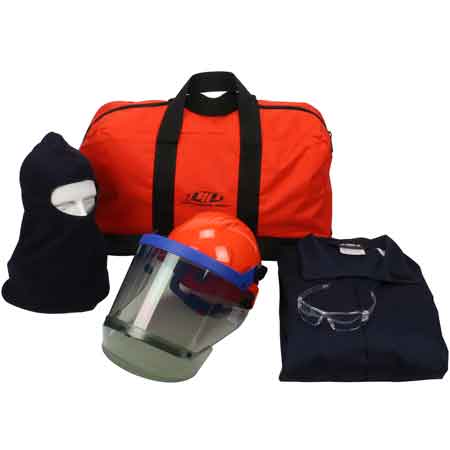Arc Flash Kit: Essential Protection
By R.W. Hurst, Editor

NFPA 70e Training - Arc Flash
Our customized live online or in‑person group training can be delivered to your staff at your location.

- Live Online
- 6 hours Instructor-led
- Group Training Available
Download Our OSHA 4475 Fact Sheet – Being Aware of Arc Flash Hazards

- Identify root causes of arc flash incidents and contributing conditions
- Apply prevention strategies including LOTO, PPE, and testing protocols
- Understand OSHA requirements for training and equipment maintenance
Arc flash kit provides PPE engineered for electrical safety, including arc-rated clothing, face shield, balaclava, rubber gloves, and tools, meeting NFPA 70E and CAT ratings to mitigate arc energy (cal/cm²) and shock risk.
Understanding an Arc Flash Kit for Compliance with NFPA 70E
An arc flash kit is an essential piece of safety equipment for electrical workers, offering critical protection in environments where electrical hazards are present. These kits are specifically designed to provide arc flash ppe, including arc flash protection clothing that shields workers from the severe risks associated with arc flash incidents, such as burns and serious injuries. Understanding the value of an arc flash kit is vital for electrical professionals, as it ensures they are equipped with the proper clothing kits to stay safe on the job. Choosing the right kit and maintaining it properly are key to preventing accidents and ensuring compliance with safety standards. For a broader overview of components and best practices, see this guide to arc flash safety equipment for context and comparisons.
Request a Free Training Quotation
What is Included in a Standard Arc Flash Kit?
A standard kit is designed to provide comprehensive protection to electrical workers exposed to potential risks. The components typically found in such kits are tailored to safeguard the body from thermal burns, flying debris, and other hazards associated with electrical faults. While the contents may vary depending on the protection level, most flash kits include:
- Arc-rated clothing: This typically consists of coveralls, jackets, and pants made from flame-resistant fabric. These garments are designed to protect workers from high heat generated by an arc event.
- Face shield: The face shield provides critical protection for the face and eyes, shielding against heat, pressure waves, and flying particles.
- Gloves: Insulating gloves, often paired with leather protectors, provide a barrier against electrical contact and protect hands from thermal injuries.
- Balaclava: This protective headgear shields the head and neck area from heat and potential debris.
- Gear bag: A durable gear bag is included for the safe storage and transport of all personal protective equipment (PPE) components. This ensures that everything stays in good condition and is readily available when needed.
Test Your Knowledge About Arc Flash!
Think you know Arc Flash? Take our quick, interactive quiz and test your knowledge in minutes.
- Instantly see your results and score
- Identify strengths and areas for improvement
- Challenge yourself on real-world electrical topics
Each kit is assembled to meet specific protection requirements, ensuring the user is equipped to face a range of electrical hazards. Understanding how different pieces of arc flash gear work together can help teams optimize protection without unnecessary bulk.
How Do I Select the Right Arc Flash Kit for My Work Environment?
Selecting the correct protection gear depends on several factors, primarily the energy level present in the work environment. This is measured in calories per square centimeter (cal/cm²), which quantifies the potential thermal energy a worker could be exposed to during an arc event. Standard kits are rated based on their ability to withstand certain levels of incident energy. For example, a commonly used 12 cal arc-rated kit provides protection for environments where the potential energy release is less than or equal to 12 cal/cm². To align selection with current standards, review applicable arc flash PPE requirements that correlate incident energy with minimum protective ratings.
Before purchasing a kit, it is essential to conduct a hazard analysis or refer to the results of one to determine the exact level of protection needed. In environments with higher energy levels, more advanced PPE with greater arc ratings is required. Additionally, consider the frequency of use and whether any specialized components—such as additional flame-resistant layers—are necessary. Field users also benefit from practical summaries of PPE for arc flash that highlight layering strategies and task-based considerations.
What Are the Arc Ratings of PPE in an Arc Flash Kit?
The arc rating of PPE is the primary indicator of the level of protection provided. Arc ratings are measured in cal/cm² and represent the amount of heat energy the PPE can absorb before the wearer sustains second-degree burns. The most common ratings for flash protection gear are 8 cal/cm², 12 cal/cm², 25 cal/cm², and above. For instance, a 12 cal PPE kit is often recommended for low-to-moderate risk environments, providing adequate protection against energy releases up to 12 cal/cm². When comparing garments, look for clear labeling of arc flash PPE so sizing, materials, and ATPV values are easy to verify in the field.
Higher-rated PPE is necessary for environments with greater potential arc energy. For example, a 40 cal/cm² kit is required for high-risk environments, providing maximum thermal protection to prevent burns in extreme conditions. Always ensure that the PPE selected aligns with the energy levels assessed in your specific work environment. Selecting durable arc flash clothing with appropriate CAT ratings also supports comfort and mobility during extended tasks.
How Often Should an Arc Flash Kit be Inspected or Replaced?
Regular inspection and maintenance of flash kits are crucial to ensure that all protective components remain in good working condition. It is recommended that workers inspect their PPE before each use, looking for any signs of wear, damage, or degradation. Pay close attention to the face shield for cracks or discoloration, as well as to the gloves and garments for tears or burns. Even minor damage can compromise the effectiveness of the equipment.
PPE should be replaced after any exposure to an arc event or when it shows significant signs of wear. Periodic replacement is also necessary, as materials can degrade over time, even if they have not been exposed to an arc. Following manufacturer guidelines and regularly reviewing the condition of your equipment will help ensure maximum protection. Maintenance logs should document inspections of arc flash safety gear to track service life and trigger timely replacement.
Is an Arc Flash Kit Required for All Electrical Work?
Not all electrical tasks require the use of a full kit. The need for such equipment is based on the potential energy release determined during a hazard analysis. For instance, if the risk assessment shows that the incident energy is below 1.2 cal/cm², minimal PPE may be required. However, for tasks involving energized equipment or areas where the potential for short circuits and arcing faults is high, flash protection kits are mandatory.
Electricity Today T&D Magazine Subscribe for FREE

- Timely insights from industry experts
- Practical solutions T&D engineers
- Free access to every issue
NFPA 70E outlines when specific PPE is required, including the use of flame-resistant clothing, face shields, and gloves. The more hazardous the work environment, the more comprehensive the PPE requirements become. It's important to note that even in environments where the risk appears low, unforeseen equipment failures can still result in dangerous arc events, making it essential to be prepared.
Protection is a critical consideration for anyone working around electrical equipment. By understanding what is included in standard kits, how to choose the right one, and how to maintain it, electrical workers can significantly reduce their risk of injury. Regular inspections and adherence to safety guidelines ensure that these kits provide the necessary protection when it matters most.








